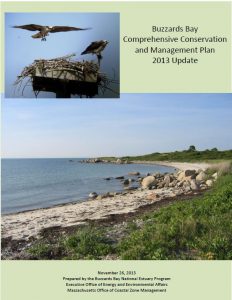2013 CCMP, Action Plan 2:
Protecting and Enhancing Shellfish Resources
About the new Buzzards Bay CCMP Action Plans
The Buzzards Bay Comprehensive Conservation and Management Plan (CCMP) was updated in November 2013 to reflect the great progress achieved since the original CCMP was finalized. We want your feedback on this action plan. First, read the complete Protecting and Enhancing Shellfish Resources Action Plan. At the bottom of this page is a link for you to provide comments on each goal, objective and defined management approach contained in this Action Plan. Based on your feedback, we will update and revise all the action plans in the new CCMP.
Protecting and Enhancing Shellfish Resources
Problem
Shellfish (molluscs and crustaceans) are an important but diminishing resource in Buzzards Bay. Catch statistics suggest that populations of many mollusk species and lobster populations are declining. Declining catch of lobster may be related to disease and water quality degradation. Mollusk catch declines are the result of habitat declines and sanitary closures. Although the acreage of shellfish bed permanent closures has declined in Buz-zards Bay in recent years, numerous areas remain permanently closed. Exacerbating the problem, funding for shellfish propagation and relay programs has been cut back appreciably in recent years.
The Massachusetts Division of Marine Fisheries (DMF) implements shellfish bed management based on ambient water quality in shellfish beds and a mostly visual evaluation of potential pollution sources along the coast (Shellfish Sanitation Survey Program). Additional coordination and collaboration is needed between DMF and municipalities to reduce closures further.
This action plan narrowly addresses steps to enhance the availability and productivity of shellfish resource areas. It compliments other action plans that target specific pollutants and impacts, especially Action Plan 3 Managing Stormwater Runoff and Promoting LID, and Action Plan 1 Managing Nitrogen Sensitive Embayments.
Goals
Goal 2.1. Increase availability of shellfish resources for recreational and commercial use.
Goal 2.2. Restore habitat to increase the abundance and distribution of shellfish resources.
Objectives
Objective 2.1. To keep open all shellfish resource areas now open, and to open priority resource areas that are now closed.
Objective 2.2. To increase the ability of DMF to carry out the sanitary survey program and provide technical assistance to municipalities to better manage shellfish resources.
Objective 2.3. To increase the capacity and commitment of municipalities to remediate pollution sources that are contributing to shellfish bed closures.
Objective 2.4. To expand the use of the conditionally approved classification for shellfish areas.
Objective 2.5. To eliminate pollution sources and disturbances contributing to the permanent loss of shellfish habitat and enhance and restore shellfish habitat.
Objective 2.6. Expand programs to propagate, seed, and relay shellfish.
Approaches
To achieve the goals and objectives of this action plan requires improved coordination and collaboration between the DMF and municipalities. To reduce bacteria concentrations, both municipalities and DMF must better monitor and document upstream pollution sources contributing to shellfish bed closures and take action to eliminate these pollution sources or minimize their impact. State sanitary surveys should be posted online to assist town boards and committees establish pollution remediation priorities. Solutions relating to shellfish habitat loss are addressed in other action plans.
Additional monitoring is essential, because “end of the pipe” solutions are expensive, and upstream source reduction strategies can often achieve the same benefits at less cost. Such monitoring can also help establish priorities to target available programs and funds to address the most problematic discharges contributing to shellfish bed closures. Additional water quality data can also enable the state to expand conditionally approved areas, or reduce the extent of permanently closed shellfish areas. These outcomes may also depend on municipalities eliminating identified pollution discharges.
Expansion of propagation or seeding programs can provide benefits to the public in the absence of broader water quality or habitat improvements. Towns can construct shellfish upwellers to meet these needs.
Costs and Financing
The legislature and local government need to provide funds for staff to implement this action plan. A watershed-scale upstream source identification program could be established at a cost of $100,000 per year if it utilized existing staff and a volunteer monitoring program like that established by the Buzzards Bay Coalition in their nitrogen pollution water quality monitoring program. Programs like EPA’s 604(b) can assist with these water-shed assessments. Funding for shellfish propagation seeding (including upwellers) and habitat creation pro-grams can be included in state and local budgets. Tackling pollution like treating stormwater discharges to open shellfish beds or reducing nitrogen to restore shellfish habitat will cost billions over decades. Those costs and issues relating to these efforts are addressed in other action plans.
Measuring Success
Acres of shellfish beds permanently closed, and commercial shellfish catch will be the principal long-term tracking measures to evaluate progress toward the goals of this action plan.
